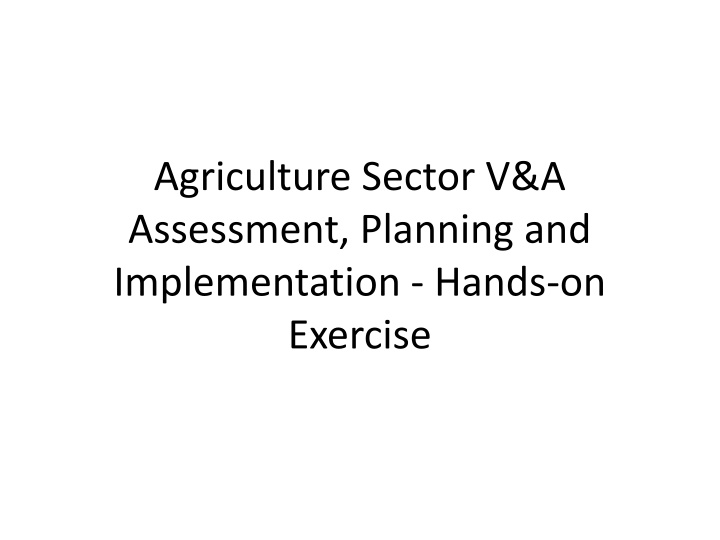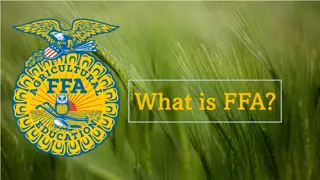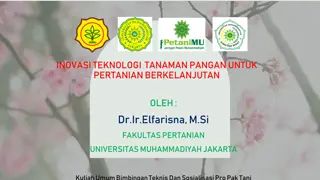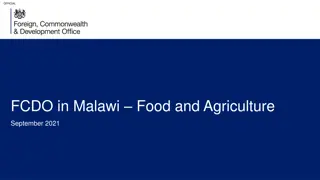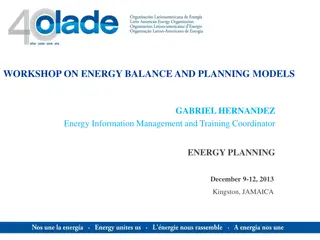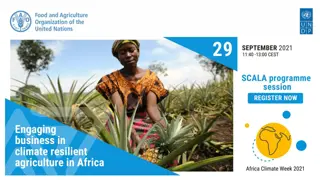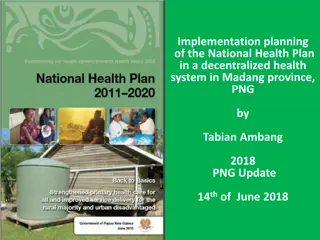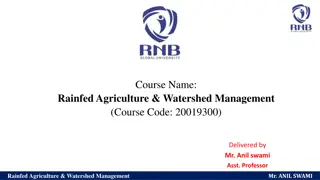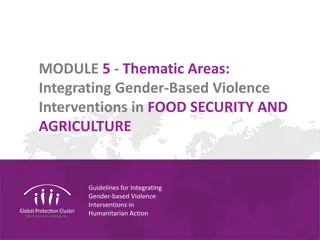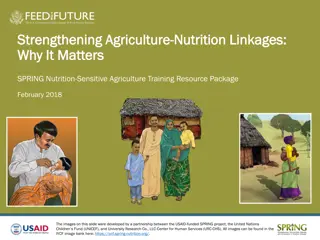Agriculture Sector V&A Assessment: Hands-on Exercises for Planning and Implementation
Explore a comprehensive V&A assessment for the agriculture sector through hands-on exercises covering types of information, seasonality, historical trends in climate and crop production, and projections for the future. Dive into specific locations, temperature variations, rainfall patterns, and crop calendars to enhance your understanding of agricultural planning and climate impacts.
Uploaded on Sep 16, 2024 | 3 Views
Download Presentation

Please find below an Image/Link to download the presentation.
The content on the website is provided AS IS for your information and personal use only. It may not be sold, licensed, or shared on other websites without obtaining consent from the author.If you encounter any issues during the download, it is possible that the publisher has removed the file from their server.
You are allowed to download the files provided on this website for personal or commercial use, subject to the condition that they are used lawfully. All files are the property of their respective owners.
The content on the website is provided AS IS for your information and personal use only. It may not be sold, licensed, or shared on other websites without obtaining consent from the author.
E N D
Presentation Transcript
Agriculture Sector V&A Assessment, Planning and Implementation - Hands-on Exercise
Overview Exercise 1: Types of information Exercise 2: Seasonality Exercise 3: Historical climate trend Exercise 4: Historical crop production trend and climatic impacts Exercise 5: Projected future
Exercise 1: Types of information
a) 2 Year-to-year variability of annual temperature in Revelle City was larger from 1990 to 2000 than in all previous decades on record. Annual rainfall increase for Manabe Heights compared to the 1961-1990 average is projected by some models to reach 200mm at the end of the century. In Croll s Crossing, corn has the shortest growing season from May to August. Fourier City receives the largest amount of rainfall in October. For Keeling Creek, Global Climate Model scenarios project a rise in annual average temperature of between 1.5 C and 3.5 C by 2100. In Douglass Ville, average mean annual temperature has increased by 0.3 C between 1920 and 1990. June is typically the hottest month in Tyndall Town measuring 27 C. 1. Seasonality in a year: seasonal climate and crop calendar b) 3 c) 1 2. Long-term trend: historical climate and historical crop production d) 1 e) 3 3. Projected future: future climate and possible changes in crop production f) 2 g) 1
Exercise 2: Seasonality
Q1 / Figure 1: Average monthly temperature (C ) in Tyndall Town over the last 20 years 29 28 27 26 25 24 23 JAN FEB MAR APR MAY JUN JUL AUG SEP OCT NOV DEC June is the hottest month (28 C). There are actually two temperature peaks in a year in this location. The second peak is October. January is the coldest (24 C). The annual average is about 26.4 C. About 4 C difference from the coldest month and the hottest month.
Q2 / Figure 2: Average monthly rainfall (mm) in Tyndall Town over the last 20 years 500 450 400 350 300 250 200 150 100 50 0 JAN FEB MAR APR MAY JUN JUL AUG SEP OCT NOV DEC It rains the most in August (450mm). November to May is dry. The total annual rainfall is about 1100mm and it is mostly concentrated in just three months from July to September.
Q3 / Figure 3: Cropping calendar (J: January, F: February ) The table appears not to list all crops grown in the area. As there is hardly any rain in the dry season, all rainfed crops are probably grown in the second half of the year like rice and millet in the table. For rainfed crops, sowing in June to August, and harvest in October to December is probably the most common cropping calendar, given the rainfall cycle. Irrigation capacity allows cropping in dry season, such as irrigated rice from February to May as in the table.
Q4 / Figure 4: Climate risk calendar (J: January, F: February) Water-related extreme events should occur around the rainy season (June to October) like drought and storms in the table. Other extreme events may be in different seasons (e.g. winds in April as in the table). Temperature-related extreme events seem to be of less importance in the area. Wind is another climate variable that deserves attention in the area.
Q5 / Figure 5: Table to combine climate risks and crop calendars Storms can affect both rice and millet. Droughts or late on-set of rainy season may not affect millet because it is sown later in the season. Irrigated rice is vulnerable to other extreme events like strong winds that rainfed crops are not exposed to.
Exercise 3: Historical climate trend
Q7 / Figure 6: Annual average temperature (C) in Crolls Crossing 27.5 27.0 26.5 26.0 25.5 25.0 24.5 24.0 1920 1940 1960 1980 2000 Problems: There are just a few years of observation in 1930s, followed by 10 years of gap. No record since 1990. A warming trend (~0.25 C from 1945 to 1990) Annual temperature may fluctuate within a 1 C range. Year-to-year variability may be larger in 1970 to 1990 than earlier decades. Daily maximum temperature and daily minimum temperature records would be nice to have. Observation in recent decades will be essential to understand current climate variability.
Q8 / Figure 7: Total annual rainfall (mm) in Crolls Crossing 2500 2000 1500 1000 500 0 1880 1900 1920 1940 1960 1980 2000 A decreasing trend (-340mm from 1890 to 1990 or about -25%) Annual rainfall may fluctuate within 1000 mm range. Changes in the size of year-to-year variability are not very apparent. Problems: A few missing years in the long time series but no record in recent 20 years. It would be nice to know if it is raining less frequently or the amount of rain in one rain event is smaller. Observation in recent decades will be essential to understand current climate variability.
Q9 / Figure 8: Historic extreme weather events by number of affected people in Croll s Crossing Droughts, floods, and storms Large floods were observed in the last 10 years, not in early decades. Large drought events happened decades ago and in recent times too. Droughts tend to affect more people than other extreme events. It does not necessarily mean that droughts affect agricultural production more than other extreme events. It would be nice to have statistics on loss in agricultural production in relation to extreme weather events for the local area (and not for the whole country).
Exercise 4: Historical crop production trend and climatic impacts
Q 10 / Figure 9: Yield year-to-year variability (t/ha) in Revelle City 3.5 3 2.5 2 t/ha 1.5 1 0.5 0 1994 1996 1998 2000 2002 2004 2006 2008 2010 Grouping: a) 1994 -1996 under 1t/ha, b) 1997-2002 1 to 2 t/ha, c) 2003-2010 more than 2 t/ha) Possible reasons for trend/jump in crop yields: e.g. introduction of fertilizers, subsidies, market price, Linear trend Other trends of non-linear trend
Q 11 / Figure 11, 12: De-trended crop yield vs. annual rainfall in Revelle City 40 Years of very bad yields correspond to low rainfall years (2001 and 2010). However equally poor yield year (2000) did not have a low rainfall Year 1994 had a very good yield despite very dry condition Annual rainfall amount can explain part of the poor yields but not all. Need to look at rainfall data at shorter time scales (monthly, daily) 30 20 10 0 % -10 -20 -30 -40 2400 2200 2000 mm 1800 1600 1400 1200 1000 Need to look at other climate variables (average temperature, daily max temperature, daily min temperature, wind speed, radiation, etc) Would be helpful to look at production statistics not by year but by cropping season (if there are two or more seasons in a year)
Exercise 5: Projected future
Q 12 / Figure 13: Projected annual average temperature change (C) in Keeling Creek with respect to 1961-1990 average; comparison of 3 GCMs and 2 RCPs 4 3.5 3 GCM1-RCP8.5 2.5 GCM1-RCP4.5 GCM2-RCP8.5 2 C GCM2-RCP4.5 1.5 GCM3-RCP8.5 1 GCM3-RCP4.5 0.5 0 1961-1990 2011-2030 2046-2065 2080-2099 More warming for RCP8.5 scenario than RCP4.5 scenario. More warming for GCM1, least warming for GCM2. Variation among GCMs and emission scenarios is not large in 2011- 2030, but it increases with time and up to 2 C in 2080-2099 (GCM1- RCP8.5: 3.5 C vs GCM2-RCP4.5: 1.6 C) All GCMs and emission scenarios agree on continuous warming through the century Need to know the effect of higher temperature on major crops grown in the area. And then think about what can be done shift sowing date? Heat-tolerant variety? etc
Q 13 / Figure 14: Projected total annual rainfall change (mm) in Keeling Creek with respect to 1961-1990 average; comparison of 3 GCMs and 2 emission scenarios Increase in rainfall in general Changes tend to be larger later in the century 100 to 250mm wetter in 2080-2099. Decrease in rainfall is possible in the near future (2011-2030) All GCMs and emission scenarios agree on wetter condition by the end of the century (2080-2099) Need to know how wetter condition might affect crop growth. If one storm will bring larger amount of water, it would be nice to know how much water soil is able to absorb and whether excess water can cause drainage problem, etc (many possible answers)
